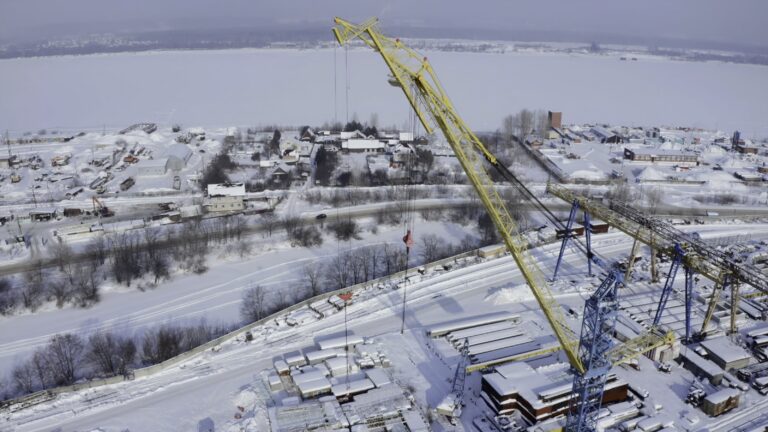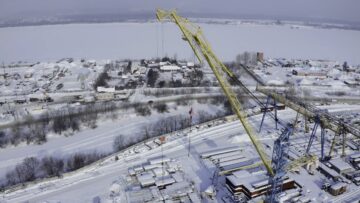The temperature is dropping, the days are getting shorter, and the frost is covering the ground. While it may be exciting to imagine a festive winter season, that is not what comes to mind when working in the construction industry. Especially, when you have a project to complete, a schedule to maintain, and a desired concrete temperature and strength to achieve. The pressure is on when dealing with factors like the freezing of concrete at an early age, and rapid temperature changes, all while trying to meet the required strength. However, there are tools that can monitor temperature and strength for this holiday concrete trouble. Let’s get started with all you need to know about pouring concrete in winter.
Explore 12 Futuristic Technology Trends Solving Concrete's Biggest Challenges.
Understanding the Role of Concrete
Concrete is the most widely used construction material in the civil engineering field. It is strong, durable, resilient, energy-efficient, involves low maintenance cost, and is the only cost-effective construction material that delivers the lowest carbon footprint for a structure over its lifecycle. Owing to its versatility, suitability for adaptive reuse, and 100% recycling, concrete is considered to be a constitutive element in the construction industry.

To best utilize the material to its full ability, it is important that we do some beforehand work to achieve desirable results. Concrete tends to behave differently under different weather conditions as the hydration chemistry changes. In general, the pouring of concrete could be carried out in different weather conditions such as normal or ideal, dry, cold, hot, humid, wet, etc., The operations of work that we had to perform associated with obtaining the end product also differ based upon these varying conditions, and that’s where the level of difficulty expands and leaves us with having to address a lot of critical factors. Cold weather concreting is one such process that involves a series of pivotal steps that need to be carefully performed in order to achieve the outcome.
Cold-Weather Concreting
The American Concrete Institute (ACI), as stated in ACI 306 defines cold weather concreting as, “a period when for more than three successive days the average daily air temperature drops below 40 degrees Fahrenheit (4.5 ℃) and stays below 50 degrees Fahrenheit (10 ℃) for more than one-half of any 24-hour period.”
In simpler words, cold-weather concreting is the process of placement, finishing, curing, and protection of concrete during cold weather as per ACI 306. This definition mainly addresses the problems with the freezing of concrete at an early age.
Challenges of Pouring Concrete in Winter
The two main constituents used in the production of concrete are cement and water. The amount of heat generated when water is mixed with cement is called the process of ‘Heat of Hydration’. This is a chemical reaction that is affected by factors such as chemical composition, curing temperature, w/c ratio, and cement fineness. This hydration process plays a significant role in impacting concrete during its strength development.

During cold weather conditions, the temperature can be extremely low, let’s say around -40℉ (-40℃), which could affect the hydration process and result in slowing down the hydration reaction affecting the strength growth. Notably, when the concrete is in a plastic state, the freezing temperature within the first 24 hours can reduce the strength by more than 50%. The concrete must achieve a minimum strength of 500 psi (3.5 MPa) typically in the first 24 hours. As per CSA A 23.1, concrete with a compressive strength of 1015.26 psi (7.0 MPa) is considered safe for exposure to freezing.
Other adverse effects that the low temperatures could have on the behavior of concrete include but are not limited to,
- Extended Setting Time
- Freezing of Concrete at early stages
- Low Concrete Strength
- Cracking
- Thawing of Concrete
- Poor Quality as a result of High Permeability
- Integrity issues on or around Cold Joints
How to Protect Concrete in Cold Weather?
Protection itself here is a broad term. It is one of the major challenges commonly faced in cold-weather concreting. When proper steps are taken during concrete production, from its placement to protection in cold weather, it will enable the development of sufficient strength. This will therefore increase durability to satisfy the intended service requirements as prescribed by ACI.
Some of the common protection steps needed to be adopted by suppliers and contractors to accomplish their goals and meet project specifications are,
- Removal of Snow and Ice
- Heating of Water and/or Aggregates
- Warming up of formwork before concrete placement
- Protection in the form of heated enclosures, coverings, and insulations.
- Controlled temperature gradient
- Avoiding Wet Curing
- Reshoring if necessary
- Protection against contact with salts
Optimizing Concrete During Cold Weather: Tracking temperature and strength
The construction industry keeps evolving and advances are being made every day. A structure can now be built even in the most unlikely places like Antarctica or outer space. Well, it is obvious that we must thank the technology with which it became achievable for us to make the impossible, possible. Though pouring concrete in winter was once a daunting experience, with improved concrete designs, pouring methods, and precautionary steps, any contractor could produce great results, even in cold weather, with the correct technology. Witnessing the latest technologies transform the civil engineering field is a real treat to the eyes, especially when it helps people build faster, safer, and more economically. Giatec’s SmartRock® sensors and SmartHub™, designed with smart IoT Testing and AI solutions, are focused on revolutionizing the concrete industry by bringing modern technology to the forefront of every job site. The SmartRock sensors are a great choice in cold-weather concreting, helping your teams easily keep track of temperature and strength any time, anywhere, on any device.










